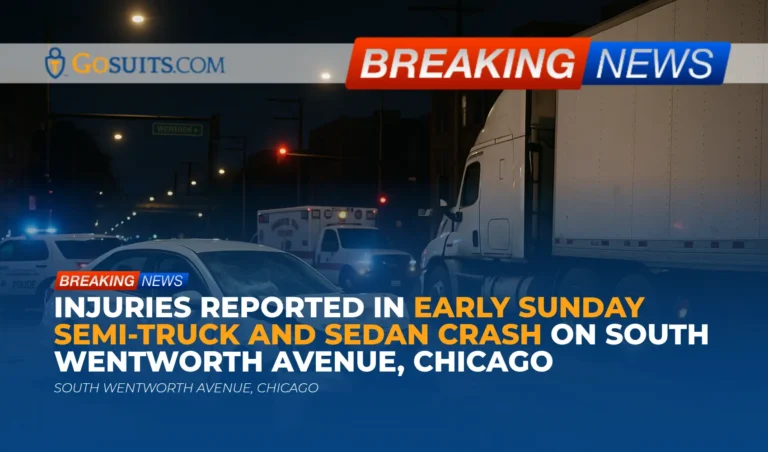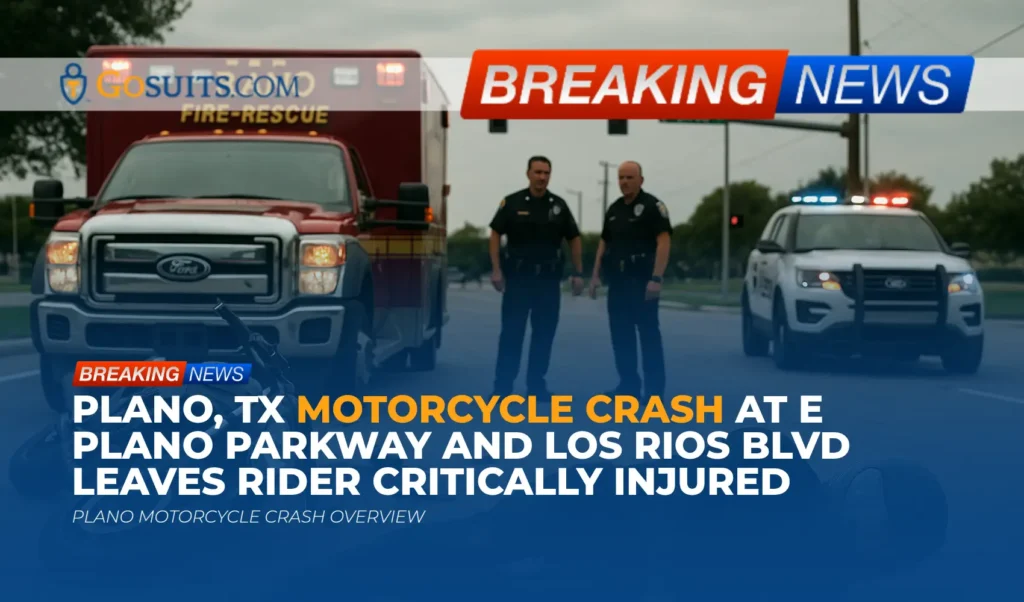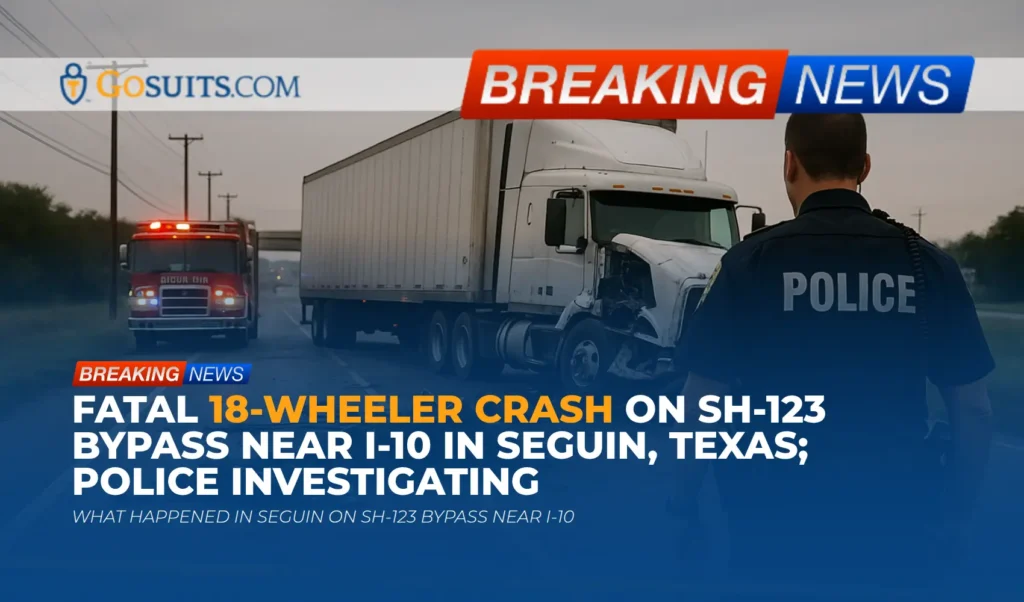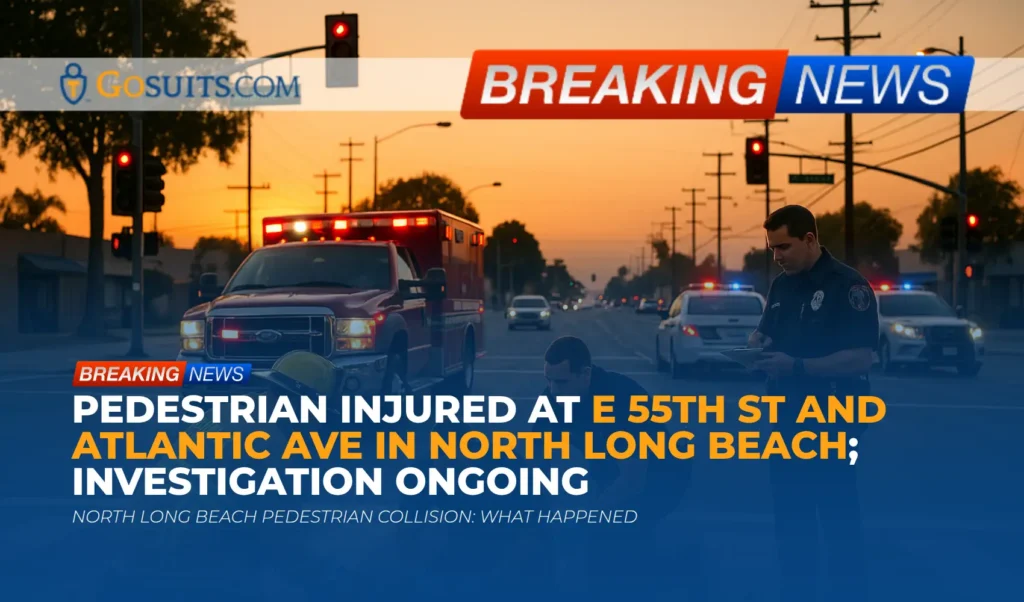- What we know about the S Wentworth Ave semi-truck crash in Chicago
- Why semi-truck and passenger car collisions are so dangerous
- Immediate steps to protect health and rights after a Chicago truck crash
- How commercial truck crashes are investigated and which evidence matters
- Who may be liable under Illinois law
- Insurance pathways and common pitfalls in commercial vehicle claims
- Key deadlines and legal time limits in Illinois
- Where and how to obtain official records and support in Cook County
- Common harms and losses after a truck crash
- If a loved one was seriously hurt or killed
- A practical timeline: from crash to resolution
- Commentary from Gosuits Chicago, Illinois Personal Injury Attorney
- Why timely action matters after a serious crash
- Sources
What we know about the S Wentworth Ave semi-truck crash in Chicago
Early Sunday morning, around 1:50 a.m. on October 19, 2025, a collision occurred on or near South Wentworth Avenue in Chicago involving a semi-truck and a white sedan. Chicago police and emergency services responded, confirmed that injuries were sustained, and worked to clear debris and manage traffic around the scene. As of the last public update, authorities had not released the number of people injured, the specific nature of injuries, or a final determination of cause. The crash remains under investigation.
Because this corridor serves both commercial traffic and local commuters, the timing and vehicle types raise familiar safety concerns. Overnight and pre-dawn hours can coincide with lowered visibility and fatigue-related risk, especially where large commercial vehicles operate alongside smaller passenger cars. While officials continue to investigate, the priority remains on the recovery of those injured and preventing similar incidents along high-traffic routes.
Why semi-truck and passenger car collisions are so dangerous
Collisions between semi-trucks and passenger vehicles can be severe because of the dramatic difference in vehicle size and mass. National data consistently show that occupants of smaller vehicles face higher risk of serious injury in crashes with large trucks. The National Highway Traffic Safety Administration highlights that the size and weight of large trucks contribute to greater crash forces, longer stopping distances, and unique blind spots, all of which can magnify injury severity for occupants of smaller vehicles. See NHTSA’s Large Trucks safety overview for context and national trends (NHTSA).
Time of day can also be relevant. Overnight hours are associated with increased fatigue, reduced visibility, and fewer visual cues. Safety guidance from federal transportation agencies consistently emphasizes the heightened hazards created by drowsy driving and nighttime conditions, which can impact commercial drivers and passenger vehicle drivers alike (NHTSA on drowsy driving).
Commercial operations add additional layers of risk and responsibility. Federal Motor Carrier Safety Regulations (FMCSRs) set minimum standards for driver hours-of-service to address fatigue (49 CFR Part 395), require periodic vehicle inspection and maintenance to reduce mechanical failures (49 CFR Part 396), and mandate drug and alcohol testing programs for safety-sensitive drivers (49 CFR Part 382). When crashes happen, investigators often look at fatigue, maintenance, loading practices, and compliance with these regulations.
Immediate steps to protect health and rights after a Chicago truck crash
In the hours and days after a serious crash, caring for health and preserving information are critical. This is a difficult time. The following steps are general, practical measures that can help safeguard well-being and protect a potential civil claim while facts are still fresh.
Medical care and documentation
- Seek prompt medical evaluation. Some injuries are not immediately obvious. Timely care documents symptoms and links them to the crash. People have a right to access their medical records for continuity of care and claims review; federal rules require timely patient access to records (HHS Right of Access).
- Follow medical advice. Attending appointments, imaging, therapy, and medications not only supports recovery but also creates a consistent record of the injury course.
Preserve evidence
- Keep photos and videos. Scene images, vehicle damage, skid marks, debris, and any dashcam footage are key.
- Save physical items. Damaged property, torn clothing, and medical devices can be evidence.
- Identify witnesses. Names, contact information, and any statements can help corroborate events.
Be careful with insurance communications
- Speak with a qualified attorney before contacting any insurance company. What is said to an insurer can be recorded and used later, sometimes out of context. An attorney can explain rights and obligations and help decide when and how to engage insurers.
- Avoid signing releases or authorizations that allow broad access to medical or employment records without understanding the scope.
Mind deadlines and follow-up
- Request the police crash report and any available supplemental materials once they are ready.
- Track all expenses related to medical care, transportation, and lost time from work.
How commercial truck crashes are investigated and which evidence matters
Truck crash investigations often involve additional layers beyond a typical passenger car crash because commercial carriers must follow federal and state safety rules. Evidence can come from many sources:
- Police crash report and scene documentation. The report records parties, vehicles, conditions, and preliminary findings. Photographs, diagrams, and supplemental narratives can be critical.
- Electronic data from vehicles. Many trucks have electronic control modules or telematics that store speed, braking, throttle, and fault codes. Passenger vehicles may have event data recorders as well. This data can be time-sensitive.
- Hours-of-service and driver logs. Paper or electronic logging device data can show operating hours, rest breaks, and potential fatigue-related issues (see 49 CFR Part 395).
- Maintenance and inspection records. Required under 49 CFR Part 396, these records can reveal brake, tire, lighting, or other mechanical issues.
- Drug and alcohol testing compliance. Post-crash testing can be required in certain circumstances; carrier compliance lives under 49 CFR Part 382.
- Load and weight documentation. Bills of lading, weight tickets, and loading procedures can affect stopping distance and vehicle handling.
- Video evidence. Dashcams, nearby storefront cameras, city traffic cameras, and private security feeds may capture the incident or pre-crash behaviors.
- 911 audio and dispatch logs. These materials can shed light on timing and response. They are often obtained through public records requests.
Because certain evidence can be overwritten or lost quickly, prompt preservation is important. Attorneys frequently send written preservation notices to commercial carriers and other custodians to prevent deletion or alteration of relevant data.
Who may be liable under Illinois law
Liability in a truck-passenger vehicle collision is fact-specific. Potentially responsible parties may include:
- The truck driver for negligent operation, such as speeding, distraction, or fatigue.
- The motor carrier/employer for the driver’s actions and for separate failures in hiring, training, supervision, maintenance, or safety compliance.
- Maintenance contractors if outsourced inspection or repair was substandard.
- Cargo loaders or shippers if improper loading contributed to loss of control or rollover.
- Vehicle or component manufacturers if a defect in design or manufacture caused or worsened the crash.
- Other roadway users whose conduct set events in motion or exacerbated the collision.
Illinois follows a modified comparative negligence framework. In brief, a person’s recovery can be reduced by their percentage of fault, and recovery is barred if their fault is more than 50 percent. The statute articulating comparative negligence appears at 735 ILCS 5/2-1116. This is general information; any allocation of fault depends on the specific facts, evidence, and applicable law.
Insurance pathways and common pitfalls in commercial vehicle claims
Commercial carriers must maintain public liability insurance with minimum limits set by federal regulations, which vary based on operation and cargo. The federal rule establishing minimum financial responsibility is at 49 CFR Part 387. In practice, multiple policies may apply, including primary liability, excess or umbrella coverage, and separate policies for trailer owners, brokers, or shippers.
Insurance carriers investigate quickly after a serious truck crash. Adjusters may ask for recorded statements, broad medical authorizations, or rapid settlements before the full scope of injuries is known. These early steps can affect outcomes down the line. The following general cautions often apply:
- Consult with an attorney before speaking to insurers. Statements can be used later and may not reflect the evolving medical picture.
- Do not assume a single policy limit controls the entire claim. Complicated commercial arrangements can involve several layers of coverage.
- Document all communications. Keep copies of letters, emails, and claim notes.
- Be mindful of medical billing coordination. Health insurance, MedPay, and liens from medical providers or benefit plans can intersect with liability insurance.
Key deadlines and legal time limits in Illinois
Deadlines can be outcome-determinative. While specific circumstances can affect timing, these general Illinois time limits provide context:
- Personal injury: In many cases, actions for injury to the person must be commenced within 2 years of the date of injury. See 735 ILCS 5/13-202.
- Wrongful death: Many wrongful death actions must be brought within 2 years of death under the Wrongful Death Act. See 740 ILCS 180/2.
- Claims against public entities: Claims involving local public entities may be subject to a 1-year limitation under the Local Governmental and Governmental Employees Tort Immunity Act. See 745 ILCS 10/8-101.
There can be exceptions, tolling rules, or different triggers depending on the facts. People often seek individualized legal guidance early to avoid missing deadlines.

Where and how to obtain official records and support in Cook County
Access to official documents helps clarify what happened and supports insurance claims or civil cases. The resources below are government or academic sources for requesting records or understanding processes related to the Chicago area.
Chicago-area police crash reports
Traffic crash reports are obtained from the agency that investigated the crash. If the Illinois State Police investigated an interstate or state highway crash, reports are available through the ISP Crash Reports portal (Illinois State Police). For crashes investigated by city or county police, request the report directly from that department; many departments provide reports online or through their records divisions. For broader public records in Chicago, the City of Chicago maintains a FOIA portal for requests related to city departments (City of Chicago FOIA).
Cook County Medical Examiner (autopsy reports)
In the event of a fatality, the Cook County Medical Examiner’s Office conducts death investigations and may perform autopsies. The office provides information on how to request postmortem examination reports and related records, along with identification, property release procedures, and family support resources.
Death certificates and vital records
Death certificates are necessary for many administrative and legal steps after a loss. While Cook County issues local certificates, statewide guidance on vital records is available from the Illinois Department of Public Health (IDPH Vital Records). IDPH provides information on eligibility, required identification, and how to request records.
Emergency medical records
Individuals have a federal right to access their health records, including emergency department notes, imaging, and discharge summaries. Providers must respond within specific timeframes and may charge limited fees. See federal guidance on patient access from HHS (HHS Right of Access).
Roadway and traffic safety programs
The City of Chicago’s Vision Zero initiative outlines strategies to reduce serious crashes on high-injury corridors through engineering, enforcement, and education work (Vision Zero Chicago). For statewide safety data and programs, the Illinois Department of Transportation provides research and crash information (IDOT).
Common harms and losses after a truck crash
Serious truck crashes can affect nearly every facet of life. The following categories often appear in claims and case evaluations:
- Medical care and rehabilitation. Emergency treatment, surgeries, imaging, hospitalization, prescriptions, physical therapy, and future care planning.
- Income and employment impacts. Lost wages, reduced hours, diminished earning capacity, and job retraining needs.
- Property losses. Vehicle repair or replacement, personal property damage, and rental or transportation costs.
- Non-economic harms. Documented pain, physical limitations, loss of normal life activities, and psychological trauma.
- Family and household impacts. Caregiving needs, role changes within the family, and the cost of assistance with daily tasks.
The full scope of losses may not be apparent immediately. Thorough medical evaluation and careful documentation over time are important to reflect the true impact of the crash.
If a loved one was seriously hurt or killed
When severe injury or loss of life occurs, the priorities shift to safety, compassionate communication, and clear documentation:
- Coordinate with the Medical Examiner. The Cook County Medical Examiner’s Office can advise on identification, autopsy, and how to obtain reports.
- Obtain certified death certificates. These are needed for many administrative steps; statewide guidance is available from IDPH Vital Records.
- Inform insurers without providing detailed statements. Policy notice requirements may exist, but recorded statements can typically wait until counsel is obtained.
- Preserve vehicles and components. Vehicles should be kept in their post-crash condition until inspection by qualified professionals.
- Collect family-incurred expenses. Travel, memorial, counseling, and related costs should be tracked.
Illinois law provides pathways for civil claims related to a death, including claims under the Wrongful Death Act and Survival Act. These are complex matters that depend on the facts, applicable law, and timelines.
A practical timeline: from crash to resolution
Every case is unique, but a general progression often includes:
- Days 1–14: Medical care; initial records requests; notice to insurers; preservation of evidence; scene and vehicle documentation; identifying witnesses and available videos.
- Weeks 2–8: Obtaining the police crash report; reviewing medical imaging and specialist evaluations; collecting wage and employment documentation; examining carrier compliance materials where available.
- Months 2–6: Ongoing treatment; in-depth review of electronic data, logs, maintenance records; damages assessment and future care planning if needed.
- Thereafter: Negotiation, potential mediation, and if necessary, litigation. Timelines vary with injury recovery, records availability, and court schedules.

Commentary from Gosuits Chicago, Illinois Personal Injury Attorney
Our hearts are with those injured in the South Wentworth Avenue crash and with the families navigating uncertainty in its aftermath. This overview is provided for general educational purposes so community members can better understand what happens next and which public resources exist.
A collision between a semi-truck and a passenger car in the early morning hours raises familiar questions about visibility, driver alertness, and compliance with safety rules designed to reduce fatigue and mechanical risk. In Chicago’s mixed-use corridors, commercial and neighborhood traffic share the same space, which can heighten the consequences when something goes wrong. Thorough fact-finding matters: from the police report to vehicle electronic data, hours-of-service logs, maintenance records, and any available video. Preserving this evidence quickly can make a real difference in understanding what happened.
Insurance carriers and corporate risk teams move quickly after serious crashes, and they are skilled at shaping the narrative early. People sometimes face pressure to give recorded statements or sign broad releases while still in pain, before a full medical picture emerges. Even small inconsistencies can be used against them later. It is often prudent to pause, get a clear understanding of rights and obligations, and ensure that communications with insurers are strategic and complete.
Free consultations can be valuable for understanding options without financial pressure. They provide a chance to discuss timelines, potential sources of recovery, and the steps needed to preserve critical evidence before it disappears.
Why timely action matters after a serious crash
Taking early, organized steps can protect health, preserve evidence, and avoid missed deadlines. The following actions explain what should be done and why timing matters, without directing this guidance at any particular person.
- Document medical needs immediately. Early evaluation captures symptoms that may evolve; prompt treatment can improve outcomes and creates a clear record for claims review. Delays can be used to question causation.
- Preserve vehicles and data. Modern truck and car electronic systems may overwrite key data in days or weeks. Early preservation helps ensure logs, telematics, and event data recorders are captured before they are lost.
- Secure the police report and public records. Crash reports, 911 audio, and dispatch logs can take time to process. Requests should be made early through the proper portals so the record is ready when needed.
- Organize employment and financial documents. Pay stubs, tax returns, and employer letters support wage-loss claims. The sooner these are gathered, the smoother the claim evaluation.
- Avoid recorded statements until counsel is consulted. Early statements may not reflect the full medical picture; waiting helps ensure complete and accurate information.
- Track deadlines. Illinois statutes of limitations can bar claims if they expire. Understanding the relevant timetable supports timely, informed decisions.
Sources
- National Highway Traffic Safety Administration (NHTSA): Large Trucks
- NHTSA: Drowsy Driving
- 49 CFR Part 395 (Hours of Service of Drivers)
- 49 CFR Part 396 (Inspection, Repair, and Maintenance)
- 49 CFR Part 382 (Controlled Substances and Alcohol Use and Testing)
- 49 CFR Part 387 (Minimum Levels of Financial Responsibility for Motor Carriers)
- 735 ILCS 5/2-1116 (Comparative Fault)
- 735 ILCS 5/13-202 (Personal Injury Limitation Period)
- 740 ILCS 180/2 (Wrongful Death Act Limitation)
- 745 ILCS 10/8-101 (Tort Immunity Act Limitation)
- Illinois State Police: Crash Reports
- City of Chicago: FOIA Portal
- Cook County Medical Examiner’s Office
- Illinois Department of Public Health: Vital Records
- U.S. Department of Health and Human Services: Right of Access
- Illinois Department of Transportation (IDOT)
- City of Chicago: Vision Zero Chicago






